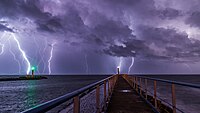
Photo from wikipedia
Abstract. The joint effects of aerosol, thermodynamic, and cloud-related factors on cloud-to-ground lightning in Sichuan were investigated by a comprehensive analysis of ground measurements made from 2005 to 2017 in… Click to show full abstract
Abstract. The joint effects of aerosol, thermodynamic, and cloud-related factors on cloud-to-ground lightning in Sichuan were investigated by a comprehensive analysis of ground measurements made from 2005 to 2017 in combination with reanalysis data. Data include aerosol optical depth, cloud-to-ground (CG) lightning density, convective available potential energy (CAPE), mid-level relative humidity, lower- to mid-tropospheric vertical wind shear, cloud-base height, total column liquid water (TCLW), and total column ice water (TCIW). Results show that CG lightning density and aerosols are positively correlated in the plateau region and negatively correlated in the basin region. Sulfate aerosols are found to be more strongly associated with lightning than total aerosols, so this study focuses on the role of sulfate aerosols in lightning activity. In the plateau region, the lower aerosol concentration stimulates lightning activity through microphysical effects. Increasing the aerosol loading reduces the cloud droplet size, reducing the cloud droplet collision-coalescence efficiency and inhibiting the warm-rain process. More small cloud droplets are transported above the freezing level to participate in the freezing process, forming more ice particles and releasing more latent heat during the freezing process. Thus, an increase in aerosol loading increases CAPE, TCLW, and TCIW, stimulating CG lightning in the plateau region. In the basin region, by contrast, the higher concentration of aerosols inhibits lightning activity through the radiative effect. An increase in aerosol loading reduces the amount of solar radiation reaching the ground, thereby lowering CAPE. The intensity of convection decreases, resulting in less supercooled water transported to the freezing level and fewer ice particles forming, thus increasing the total liquid water content. Therefore, an increase in aerosol loading suppresses the intensity of convective activity and CG lightning in the basin region.
Journal Title: Atmospheric Chemistry and Physics
Year Published: 2020
Link to full text (if available)
Share on Social Media: Sign Up to like & get
recommendations!